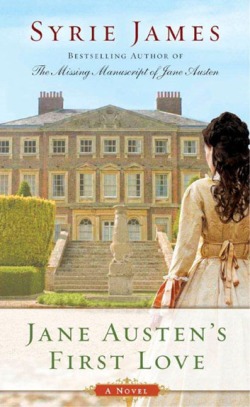 Syrie James’s new work, Jane Austen’s First Love, tells the tale of one Edward Taylor as a possible first love, pre-Tom Lefroy, for Jane Austen. It is fiction, but there is too much truth in the story, based largely on the few comments Austen made in letters to her sister Cassandra and James’ in-depth research into Taylor’s life, to have us shelve this book as merely a pretty fiction.
Syrie James’s new work, Jane Austen’s First Love, tells the tale of one Edward Taylor as a possible first love, pre-Tom Lefroy, for Jane Austen. It is fiction, but there is too much truth in the story, based largely on the few comments Austen made in letters to her sister Cassandra and James’ in-depth research into Taylor’s life, to have us shelve this book as merely a pretty fiction.
You can read Syrie’s post about it here at Jane Austen in Vermont and on various other blogs [see the full list here]
Syrie also wrote in more detail about Edward Taylor here: http://englishhistoryauthors.blogspot.com/2014/12/edward-taylor-of-bifrons-jane-austens.html – Ron Dunning, of Jane Austen genealogy fame, on reading about Syrie’s book, did some research into this Edward Taylor and has found some amazing connections to Jane Austen’s family – you will see that though Jane may not have had Edward Taylor for herself, future generations saw the Austen and Taylor families very much entwined… so here is Ron to tell us all about it. And thank you Ron for sharing this with us!
*************
A Postscript to Jane Austen’s First Love, by Ronald Dunning
Jane Austen may have been unlucky in her love for Edward Taylor, but four members of his family were more receptive to the attentions of hers. It can be illustrated in a drop-chart of the descendants of Edward Taylor’s parents, Edward Taylor the elder, and Margaret Taylor, to be found on the following link [and see below for an abbreviated version so you can follow the generations]: http://wc.rootsweb.ancestry.com/cgi-bin/igm.cgi?op=DESC&db=janeausten&id=I17370
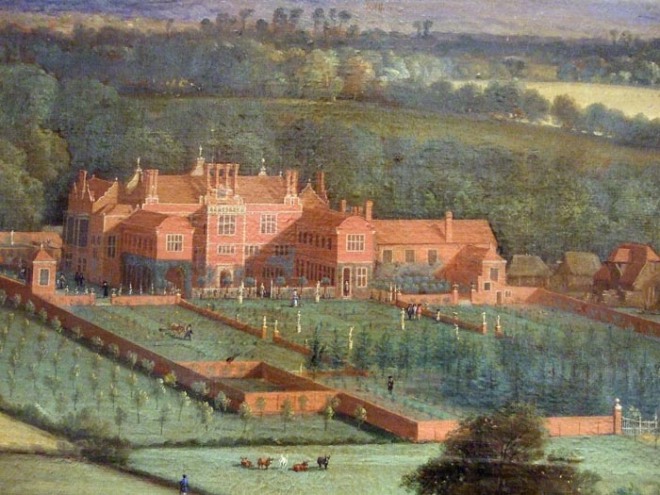
Bifrons Park, Kent
The number given to each person indicates the level of descent, with the elder Edward and Margaret in the first position. Their daughter Charlotte [JA’s Edward Taylor’s sister] married the Rev. Edward Northey, a Canon of Windsor, and two of that couple’s daughters married sons of Edward (Austen) Knight.
I. The first, Charlotte Northey, married Henry Knight [son of JA’s brother Edward], after his first wife, Sophia Cage, had died. Poor Charlotte had a very short married life too, dying three years later. Their one daughter, Agnes Charlotte Knight, married Narborough Hughes D’Aeth. Agnes had the good fortune that her mother lacked, and lived a long life of ninety years, during which she bore at least thirteen children.
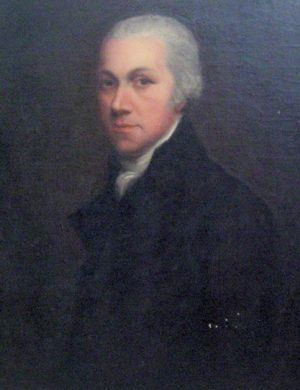
Rev Edward Northey
[you can read about the Northey family here]
The surname D’Aeth is pronounced Death by the family. I’m told that during the Second World War a Commander D’Aeth of the Royal Navy was promoted to Captain, but his men refused to serve under a Captain Death – so he felt it was best to change his surname. [One plug, if I may – the names Narborough and Cloudesley were given to many boys born to the D’Aeth family, and the reason is interesting. I wrote about it in an article, to be found here: http://www.janeaustensfamily.co.uk/articles/longitude.html]
II. Returning to the chart, Charlotte Northey’s sister, Mary Northey, married Henry Knight’s brother, the Rev. William Knight. Mary was, like her sister, a second wife, and more than twenty years younger than William. She became the step-mother to his eight children, and bore three daughters of her own, those on the chart. Unfortunately she too was visited by tragedy – the daughters, aged between two and five, all died within a week of one another, from smallpox.
III. There were two further connections, both among the descendants of Jane Austen’s fondly-doted-upon Edward Taylor. (Edward is half-way down the chart, the second person with the generational number 2.) His great-granddaughter Dorothy Mary Deedes (generation 5) married Lionel Charles Edward Knight, a great-grandson of JA’s brother Edward Austen Knight. Fortunately, there is no need to report a family tragedy here, since she lived into ripe old age.
IV. The fourth connection is less obvious – still a descendant of the younger Edward Taylor, but not a person who married a Knight. Nevertheless she brings the story full circle. Dorothy Mary Deedes’s brother, Herbert William Deedes [so Edward Taylor’s great-grandson, but also the great-great-nephew of Edward Austen Knight’s wife Elizabeth Bridges – confused enough now??], had a daughter who is simply identified in the chart as ‘Living Deedes,’ because she is still living. She is the dowager Lady FitzWalter of Goodnestone Park – whence Lady Bridges wrote to announce the betrothal of her daughters, one of them her daughter Elizabeth who married Edward Austen Knight! [see Syrie’s post here on Lady Bridges’ letters]  With the Austen pedigree, where one story ends, another begins – Lord and Lady FitzWalter were cousins, both descended from the Bridges. But let’s leave it for another time …
With the Austen pedigree, where one story ends, another begins – Lord and Lady FitzWalter were cousins, both descended from the Bridges. But let’s leave it for another time …
************
Thank you Ron for this! – I append here a portion of the genealogy chart that shows these connections – please visit Ron’s genealogy page http://wc.rootsweb.ancestry.com/cgi-bin/igm.cgi?op=DESC&db=janeausten&id=I17370 for the full chart and links from each name – it is all quite daunting, and why I am showing here only the names that connect Taylor and Jane Austen!
The Edward Taylor Sr Genealogy:
1 Edward TAYLOR of Bifrons; Rector of Patrixbourne b: 26 AUG 1734 [JA’s Edward Taylor’s father]
+ Margaret TAYLOR (LATER PAYLER) b: ABT 1743 d: 27 APR 1780
2 Charlotte TAYLOR d: 19 FEB 1837 [Edward Taylor’s daughter]
+ Edward NORTHEY MA, Canon of Windsor b: 22 OCT 1754 d: 18 FEB 1828
3 Charlotte NORTHEY d: 28 JUN 1839 [Edward Taylor’s grand-daughter]
+ Henry KNIGHT b: 27 MAY 1797 d: 1843 [son of Edward Austen Knight, JA’s brother]
4 Agnes Charlotte KNIGHT b: 1837 d: 1927 + Narborough Hughes D’AETH of Knowlton Court, Kent; JP, DL, MA b: ABT 1821 d: 1886
5 Lewis Narborough Hughes D’AETH b: 13 MAR 1858 d: 21 OCT 1920
+ Eleanor Frances SNEYD b: ABT 1866
3 Mary NORTHEY b: ABT 1820 d: 07 DEC 1854 [Edward Taylor’s grand-daughter]
+ William KNIGHT Rector of Steventon b: 10 OCT 1798 d: 05 DEC 1873 [son of Edward Austen Knight, JA’s brother]
4 Mary Agnes KNIGHT b: 1843 d: 15 JUN 1848
4 Cecilia KNIGHT b: 1844 d: 09 JUN 1848 4 Augusta KNIGHT b: 1845 d: 09 JUN 1848
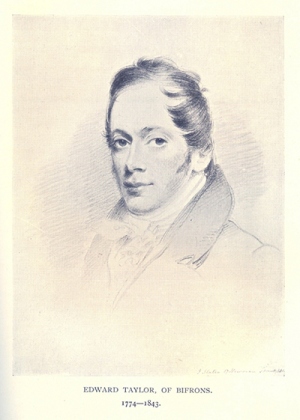 2 Edward TAYLOR Esq., of Bifrons, co. Kent; MP for Canterbury (1807-1812) b: 24 JUN 1774 d: 22 JUN 1843 [this is JA’s Edward Taylor, brother to Charlotte Taylor – her daughters Charlotte and Mary each married Jane Austen’s nephews Henry and William as shown above]
2 Edward TAYLOR Esq., of Bifrons, co. Kent; MP for Canterbury (1807-1812) b: 24 JUN 1774 d: 22 JUN 1843 [this is JA’s Edward Taylor, brother to Charlotte Taylor – her daughters Charlotte and Mary each married Jane Austen’s nephews Henry and William as shown above]
+ Louisa BECKINGHAM
3 Emily Octavia TAYLOR
+ William DEEDES of Sandling Park, co. Kent; JP, DL, MP for East Kent b: 17 OCT 1796 d: 30 NOV 1862
4 Louisa DEEDES
4 Emily DEEDES
4 Mary DEEDES
4 William DEEDES b: 11 OCT 1834
4 Herbert George DEEDES King’s Royal Rifle Corps; of Saltwood Castle b: 28 SEP 1836 d: 05 MAY 1891
+ Rose Elinor BARROW
5 Dorothy Mary DEEDES [great-grand-daughter of Edward Taylor]
+ Lionel Charles Edward KNIGHT b: 13 NOV 1872 d: 29 JAN 1931 [great-grandson of Edward Austen Knight, Jane Austen’s brother]
6 Elizabeth Margaret KNIGHT b: 12 MAY 1909 d: 1996
+ Ian Charles Rose ROSE d: 11 DEC 1962
5 Herbert William DEEDES of Galt, Hythe, co. Kent, and formerly of Sandling Castle and Saltwood Castle
+ Melesina Gladys CHENEVIX-TRENCH JP b: 11 SEP 1884 d: 16 JAN 1966
6 William Francis DEEDES Lord Deedes of Aldington (Kent); Editor of the Daily Telegraph b: 1913 d: 2006
6 Living DEEDES [dowager Lady FitzWalter of Goodnestone Park]
+ FitzWalter Brook PLUMPTRE 21st Baron FitzWalter b: 15 JAN 1914 d: 14 OCT 2004
*************************
Is your head spinning yet??! If you have questions, please ask away – and any comments on Syrie’s original post will qualify you for the Grand Giveaway – deadline is tonight December 21 at 11:59pm. And just to make your head continue in its spin, here is a portrait of “The Children of John Taylor of Bifrons Park,” by John Closterman, 1696? [from the National Portrait Gallery] – one of these boys is presumably Jane’s own Edward Taylor’s grandfather Herbert Taylor [though he seems to have been born in 1698, so perhaps the dating of the portrait is off? – more questions to ponder!]
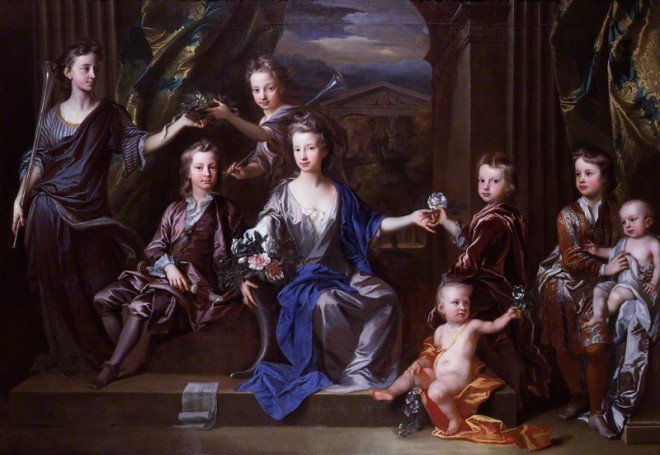
2014 Jane Austen in Vermont

















































